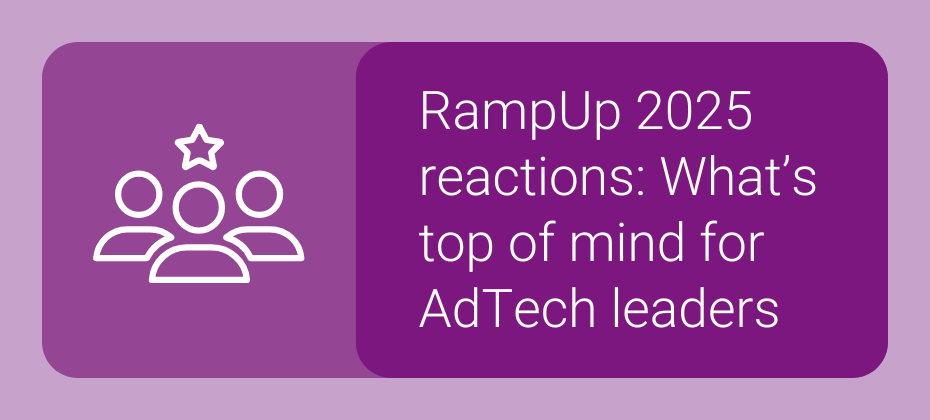At A Glance
With Experian’s Digital Graph, a leading DSP resolved 84% of IDs and increased match rates across digital channels such as CTV and display. The result: stronger attribution, clearer ROI proof, and renewed client confidence.Demand-side platforms (DSPs) are more than just technology providers, they’re strategic partners, helping marketers answer the key question: “How should I spend my media budget?”
A leading DSP struggled to attribute consumer actions across digital channels such as connected TV (CTV) and display. Without connecting impressions to conversions, they risked losing client trust and ROI proof. With Experian’s Digital Graph, they resolved 84% of IDs and increased match rates, strengthening attribution and client confidence.
The challenge

A leading DSP had trouble showing which ads drove results across CTV, display, and digital. Without linking ad views to conversions, they couldn’t prove ROI.
The missing piece was attribution. They needed to show which channels drove conversions, but without strong identity resolution, it was hard to connect CTV ads to website activity.
What is Experian’s Digital Graph?
Built from trillions of real-time data points and updated weekly, Experian’s Digital Graph connects billions of identifiers across devices and households, such as cookies, mobile ad IDs (MAIDs), CTV IDs, IP addresses, universal IDs, and more. It gives DSPs a reliable foundation by linking these identifiers back to households and individuals, improving DSPs’ ability to offer attribution by better connecting impressions to conversions.
What makes the Digital Graph unique is its scale and freshness. It ingests trillions of signals in real time and delivers updates weekly. That consistency matters: it gives DSPs confidence that they’re working with the most accurate view of digital identity.
AI and machine learning (ML) are core to how we maintain that level of accuracy. Our models use sophisticated clustering algorithms to analyze device connections at both household and individual levels. By evaluating data points such as timestamps, IP addresses, user agents, cookie IDs, and device identifiers, these algorithms create precise device groupings that enhance targeting and measurement accuracy. The models are continuously refined, ensuring our clients can better understand consumer behaviors within households and activate more effective, personalized marketing.
Think of it like connecting puzzle pieces scattered across devices and channels. On their own, each piece doesn’t say much. Together, they reveal the full picture of who saw an ad, engaged, and converted, and which ads performed best.
The solution
This expanded identity universe gave the DSP a unified view of individuals and households, making it possible to connect impressions to conversions across devices and channels. With each weekly refresh, attribution models stayed accurate and up to date, turning fragmented signals into proof of performance.
Results
With a stronger foundation of digital identifiers, the DSP matched more MAIDs, CTV IDs, and IP addresses to conversions. This allowed them to show clients exactly which ads and channels drove ROI, transforming impression reports into actionable proof of performance and strengthening client trust.
Why attribution matters now

Attribution has never been more critical. With signals fading and marketing budgets under pressure, DSPs need reliable data to prove performance.
Experian’s Digital Graph takes a multi-ID, always-on approach, refreshed weekly with trillions of signals. This delivers consistency and accuracy that single-point, stale-ID solutions can’t match.
For this DSP, that meant transforming attribution from guesswork into clear proof, strengthening client trust, and proving ROI across channels.
Connect with us today to see how our Digital Graph can help you maximize advertiser trust and ROI.
Ready to strengthen your approach to attribution?
FAQs
Experian’s Digital Graph is a privacy-conscious identity resolution solution built from trillions of real-time data points, refreshed weekly, that links identifiers like cookies, MAIDs, CTV IDs, Unified I.D. 2.0 (UID2), ID5 IDs and IP addresses to households and individuals.
Experian’s Digital Graph improves attribution by connecting impressions to conversions across devices and channels, giving DSPs a clearer view of which ads and channels drove results.
While many platforms rely on single, static IDs, Experian’s Digital Graph uses a multi-ID, always-on approach with weekly refreshed, ensuring accuracy even as signals shift.
When you use Experian’s Digital Graph, you can expect higher match rates, more synced IDs, clearer attribution models, and stronger proof of ROI for your clients. Because Experian’s Digital Graph serves as the backbone of the industry, it also helps DSPs maximize the scale and reach they can deliver to advertisers.
Yes. Experian’s Digital Graph is designed with privacy in mind, ensuring compliance while still delivering accurate attribution insights.
Latest posts

Advertising today is more complex than ever. Consumers demand personalized, relevant experiences from brands, making it increasingly challenging to meet expectations without external support. Businesses must work with publishers, retailers, and platforms to thrive, using these partnerships for data insights that refine their strategies and fuel growth. We spoke with industry leaders from Ampersand, AppsFlyer, Audigent, Comcast Advertising, Fox, ID5, and Snowflake to gather insights on how strategic collaboration can expand audience reach, improve targeting precision, and drive measurable advertising success. 1. Expand your reach with strategic collaborations Gone are the days when brands relied solely on third-party data. By linking their first-party insights with equally valuable data from partners, brands develop a far more comprehensive understanding of their audiences. This collaborative approach creates richer audience profiles, improves targeting, and enhances campaign performance. Partnerships also create opportunities for operational efficiencies. For instance, brands that share data and expertise with collaborators can expand their audience reach without overhauling existing systems. These collaborations allow marketers to work smarter, turning shared knowledge into strategic wins. "Partnerships are everything. We can't fulfill our goals on the sale side, marketers can't fulfill their goals of finding their audience where they need to reach them and with the right level of outcomes without partnering together. Why? Because each of them has their own line of sight to the data that they have access to and the data that they know best."Justin Rosen, Ampersand 2. Identify the right partnership model Choosing the right partnership model is key to achieving your business objectives. For some, pairing first-party data with publishers' insights creates better targeting. For others, aligning with complementary brands allows them to engage shared audiences. For large-scale efforts, agencies can unify collaboration frameworks, making onboarding and activation seamless. Meanwhile, emerging categories like FinTech, hospitality, and commerce media provide brands new avenues for impactful partnerships. Evaluating these options thoroughly will ensure your collaboration aligns with long-term marketing goals. "With first-party data being really the central point of signal today, we see more and more of our advertisers identifying partnerships with maybe potentially historical competitors or partners they would've never considered."Tami Harrigan, AppsFlyer 3. Utilize the power of pooled insights Combining various data sources, like CRM records, browsing behavior, and shopping receipts, creates an in-depth view of your customers. By understanding what motivates consumers at every stage of their journey, brands can better tailor messaging and funnel marketing spend to where it matters most. This approach also enables data-driven agility. Real-time insights help brands make informed adjustments, whether it’s shifting strategies mid-campaign or identifying new growth opportunities. When brands share data responsibly, the results are campaigns that resonate and deliver measurable improvements. "A lot of advertisers have gotten smarter about their data than they were just two, three years ago. They’re now doing that segmentation on their side with their data and bringing that to Fox and saying, ‘Look, match this segment against your entire user base.’ In order to do that, we can work with providers like Experian, or with data clean rooms to really bring that data and do a direct match without going through a third party."Darren Sherriff, Fox 4. Adopt the right tools and technology The right tools empower a collaborative data ecosystem. Solutions like data clean rooms ensure privacy-first data matching and measurement. Identity frameworks, such as Unified ID 2.0 (UID2) or ID5, enable secure data alignment across platforms, simplifying audience targeting while safeguarding sensitive information. Shared dashboards are another crucial tool, providing all collaborators with clear, co-owned performance metrics. Yet, while technology is an enabler, success ultimately depends on how well tools align with each partner’s goals and build trust within the collaboration. “You have to make it accessible to non-technical personas and you have to have the ability to have it stood up and pay dividends in a short amount of time. The other thing is interoperability. We very much think as an industry we need to have interoperability with clean rooms, ones that operate on different frameworks.” David Wells, Snowflake 5. Overcome barriers to collaboration Collaboration often faces obstacles, like differing goals, fragmented data, or resource gaps. Brands can tackle these issues by aligning stakeholders on clear KPIs, standardizing data-sharing practices, and selecting tools that integrate smoothly with existing systems. Breaking down barriers early fosters fluid cooperation and improves outcomes for everyone involved. When goals, tools, and resources are in sync, these partnerships deliver lasting value and stronger results. “The key is to bring together data assets and work collaboratively to address fragmentation. The way to solve that is with more interoperability and connect the data in very privacy-safe ways, offering more opportunity to reach high fidelity audiences and incorporate better measurement methodologies.”Carmela Fournier, Comcast Advertising The path to growth through partnership Those who prioritize collaboration will outrun the competition and drive sustainable growth through smarter, more connected advertising. By choosing the right models, using powerful technology, and addressing potential obstacles, brands can co-create campaigns that resonate deeply with their audiences. Connect with our experts Latest posts

RampUp 2025 brought together some of the smartest minds in AdTech to talk about the future of our industry. I had the opportunity to ask attendees key questions about AI, data collaboration, and the challenges they wish they could solve instantly. Here’s what they had to say. Watch my interviews here AI is everywhere in ads—How is it changing things? AI’s influence on advertising is undeniable, and industry leaders at RampUp 2025 emphasized how it is transforming the way data is used across marketing workflows. The increasing presence of Generative AI like ChatGPT is making it easier to stitch together data from various sources and act on insights, helping marketers execute campaigns with more efficiency. AI is no longer just about automation; it is now deeply embedded in audience building, personalization, and measurement, enabling marketers to optimize every step of the customer journey. What’s the one AdTech headache you’d fix forever? AdTech leaders agreed that some industry challenges have lingered for too long. Many expressed frustrations with the ongoing conversation about unifying cross-screen targeting and measurement. While the technology exists, aligning business priorities remains a roadblock. Others highlighted issues like the complexity of billing and reporting, which still needs to be faster and more reliable. There was also a strong push to educate brand marketers on the continued impact of offline media, such as billboards, and how data-driven strategies can enhance the effectiveness of out-of-home advertising. Beyond these operational challenges, another recurring theme was the increasing importance of identity as the backbone of effective advertising. While brands are focused on collecting first-party data, the true challenge lies in activating that data at scale. Without a strong identity resolution strategy, first-party data alone is not enough to create meaningful audience connections across multiple platforms and devices. What's one AdTech tool or strategy you can’t live without? When it comes to must-have tools and strategies, data collaboration and clean rooms emerged as essential. These solutions help companies, agencies, and publishers work together seamlessly while maintaining security and efficiency. Another key strategy discussed was traffic shaping, which allows advertisers to push activation closer to publishers, reducing data leakage and improving overall performance. Both of these approaches are critical for advertisers aiming to scale. However, as brands continue to seek more flexibility and efficiency, the conversation at RampUp expanded beyond individual tools toward a broader industry transformation. Interoperability has become a top priority, with brands, platforms, and data providers focused on ensuring seamless connectivity across clean rooms, customer data platforms (CDPs), and activation partners. The days of being locked into a single walled garden are over—the future is about data portability. "RampUp made it clear that the industry is shifting toward curated, interoperable, and always-on identity solutions—and Experian is perfectly positioned to lead this next phase of growth."Suzanna Stevens, Sr. Enterprise Partnerships Manager This shift is also driving changes in how brands manage identity. Rather than relying on one-off data onboarding, companies are increasingly adopting subscription-based identity solutions that provide an always-on, continuously refreshed identity graph. This model ensures that brands have up-to-date customer profiles while reducing inefficiencies associated with batch processing. What privacy regulations should marketers be watching? Privacy remains one of the most pressing concerns in AdTech, and industry experts highlighted the need for a better approach to regulation. Consent management was identified as a major priority since it is fluid and directly impacts how marketers engage with consumers. There was also a strong sentiment that the current state-by-state approach to privacy regulation in the U.S. is unsustainable. Instead, the industry would benefit from a national framework that simplifies compliance and ensures more consistent data governance across all states. Final thoughts from RampUp 2025 RampUp 2025 showcased the rapid shifts happening in AdTech, from AI-driven efficiencies to the growing importance of data collaboration and privacy-first strategies. As the industry works to solve long-standing challenges, such as unification and regulatory fragmentation, innovation continues to drive new opportunities. Experian remains committed to helping advertisers and marketers navigate these changes by enabling smarter, more connected, and privacy-conscious advertising solutions. We’re excited to see how these themes evolve throughout the year and look forward to collaborating with our partners to shape the future of digital advertising. Follow us on LinkedIn or sign up for our email newsletter for more insights on the latest industry trends and data-driven marketing strategies. Contact us Latest posts

Originally appeared in AdExchanger Navigating the world of data and identity partners feels like scrolling through a dating app: a sea of options, but only a select few worth swiping right. To find your perfect match, look for a partner who ticks all the right boxes. Here’s your guide to finding your perfect match. 1. Identity resolution: It all starts with a strong foundation Great identity resolution depends on a rock-solid foundation. The best partners rely on offline data—like names, addresses, and emails—that rarely change, ensuring a consistent view of households, individuals, and their devices over time. You want someone who gives you the same understanding of your audience across every stage of a campaign. 2. In search of: A well-rounded, reliable identity partner When evaluating identity graphs, it’s essential to distinguish between digital-only graphs, offline graphs, and those rare gems who combine both. Digital graphs rely on digital identifiers, while offline graphs are grounded in persistent identifiers like name, address, and phone number. A partner who offers both creates a more complete and reliable view of consumers across channels, resulting in more effective targeting and measurement. 3. Match rates are like dating profiles—don’t be fooled by the numbers Match rates can look impressive, but they’re often misleading. They can also vary widely depending on the methodology and the IDs being tested. Some providers inflate match rates by limiting the scope of comparison or tweaking their standards. The real indicators of quality are the depth of the data, the quality of matches, and how often the graph is refreshed. Ideally, your partner updates their graph weekly or monthly. The inclusion of inactive IDs may inflate the perceived scale without reflecting the true addressable audience. It's like having a profile photo from ten years ago–a major no-no. 4. Authentic origins: Is their data genuine or just a catfish? Look into your partner’s data sources and place a premium on those with public records or direct to consumer relationships. Ask if they have the experience and expertise when it comes to all aspects of data processing from accuracy to privacy and security. Look for some clear third-party indicators for accuracy, like ratings from Truthset, but there is also a basic reality: either your partner is focused on privacy and accuracy, or they are just playing the scale game. Swipe left on those playing games. 5. The breadth to impress Depth matters as much as quality. Seek a partner with wide-ranging attributes that span key audience categories like demographics, interests, and purchase behavior. They should offer the flexibility to deliver both granular data scores and broad audience segments, empowering you to reach the right consumers across channels effectively. 6. The total package: Does your partner really have it all? A true, lifelong partner connects the dots seamlessly, offering a blend of data and identity that link households to devices while layering in rich marketing insights. This approach helps advertisers better understand their customers, reach the right audiences across channels, and measure the impact of their campaigns. The right partner is well-connected and ensures that all the pieces—identity, data, and activation—work in harmony. 7. Future-proof charm: Will they ghost you when cookies crumble? With the Identifier for Advertisers (IDFAs) gone, cookies on the wane, and IP addresses under scrutiny, a partner’s ability to adapt is critical. The most future-proofed solutions are based on offline identifiers like names and addresses, which are user provided and consented data points–making them more resistant to privacy changes. Additionally, look for partners who have made the necessary investments and are prepared to support the new wave of addressable IDs emerging as alternatives to traditional signals. 8. Privacy savvy: Do they respect boundaries? As privacy laws evolve, you need a partner with a strong history in privacy compliance and proactive leadership in navigating new regulations. Strong and transparent privacy policies and participation in privacy organizations are a good indicator of trustworthiness, especially as new rules emerge across different states. Look for a partner who takes data privacy as seriously as you do and gives you peace of mind when handling sensitive information. 9. Seamless connectivity: Do they play well with others? Data is only as useful as it is actionable. Connectivity across platforms is essential, so choose a partner with seamless integrations into the major platforms you rely on for advertising. This ensures your data quality and identity resolution remain intact throughout your campaigns, avoiding loss from multiple handoffs. 10. Killer customer service: Are they in it for the long haul? A great partner collaborates to solve challenges, not just to sell or upsell. Long-standing partnerships and testimonials about strong customer service are key indicators of reliability. Choose a partner who educates and guides you through technical and strategic challenges, fostering an environment where problem-solving and innovation thrive. Keep your standards high Only a handful of companies can meet these rigorous criteria, and you should refuse to settle for a partner that lacks any of these key dimensions. Successfully navigating signal loss, privacy compliance, and seamless omnichannel integration requires extensive resources, robust infrastructure, and years of expertise. Download our full matchmaking guide So, swipe right on a partner who can handle the complexities of modern marketing and deliver consistent, scalable successful marketing outcomes. Could we be your perfect match? Find out if it's a match today Latest posts

